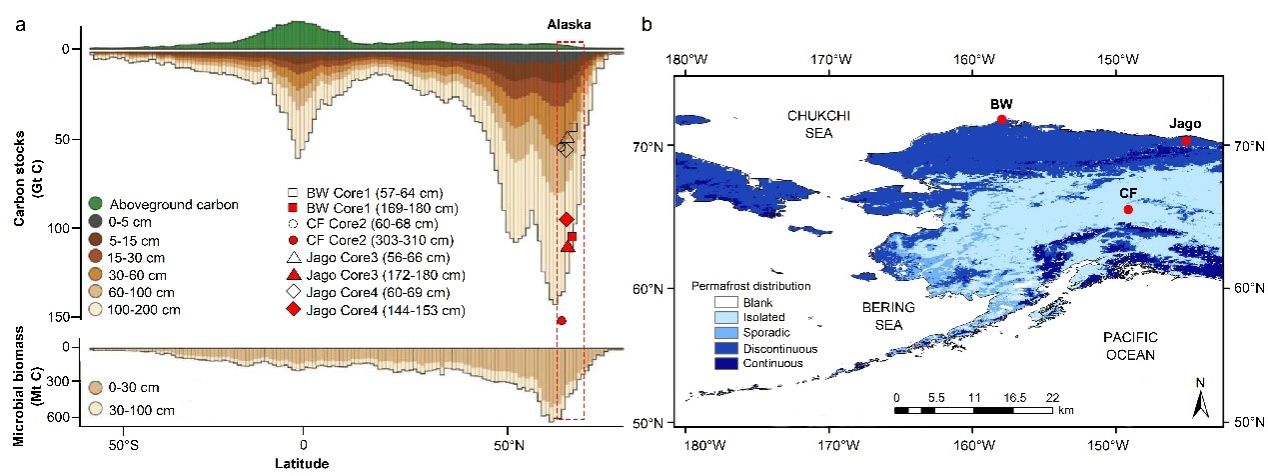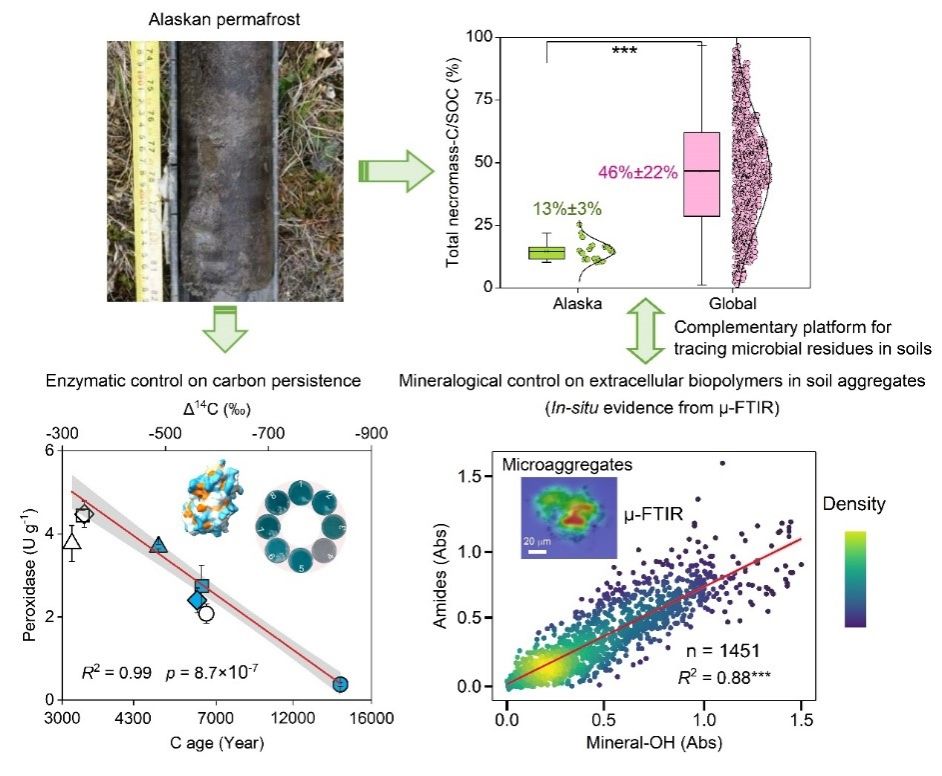Understanding the fate of organic carbon in thawed permafrost is crucial for predicting climate feedback. While minerals and microbial necromass are known to play crucial roles in the long- term stability of organic carbon in subsoils, their exact influence on carbon persistence in Arctic permafrost remains uncertain. Our study, combining radiocarbon dating and biomarker analyses, showed that soil organic carbon in Alaskan permafrost had millennial- scale radiocarbon ages and contained only 10%–15% microbial necromass carbon, significantly lower than the global average of ~30%–60%. This ancient carbon exhibited a weak correlation with reactive minerals but a stronger correlation with mineral weathering (reactive iron to total iron ratio). Peroxidase activity displayed a high correlation coefficient (p < 10−6) with Δ14C and δ13C, indicating its strong predictive power for carbon persistence. Further, a positive correlation between peroxidase activity and polysaccharides indicates that increased peroxidase activity may promote the protection of plant residues, potentially by fostering the formation of mineral- organic associations. This protective role of mineral surfaces on biopolymers was further supported by examining 1451 synchrotron radiation infrared spectra from soil aggregates, which revealed a strong correlation between mineral OH groups and organic functional groups at the submicron scale. An incubation experiment revealed that increased moisture contents, particularly within the 0%–40% range, significantly elevated peroxidase activity, suggesting that ancient carbon in permafrost soils is vulnerable to moisture induced destabilization. Collectively, this study offers mechanistic insights into the persistence of carbon in thawed permafrost soils, essential for refining permafrost carbon- climate feedbacks.

Figure 1. Carbon stocks and geographic distribution of study sites in Alaska, USA. (a) This illustration shows the latitudinal distribution of organic matter in various terrestrial ecosystems, adapted from Crowther et al. (2019), underscoring the significance of Alaskan permafrost subsoils. (b) Overview map highlighting the study sites, indicating the precise locations of the permafrost drill cores using red markers. A total of eight permafrost soil samples from four different soil cores were gathered from Barrow (BW), Creamers Field (CF), and Jago near Fairbanks in Alaska. Map lines delineate study areas and do not necessarily depict accepted national boundaries.

Figure 2. Key findings for the intricate control of minerals on deep soil carbon stability and persistence in Alaskan permafrost
The research has been published in Global Change Biology (2024, 30: e17552) as the Article “Deciphering the Intricate Control of Minerals on Deep Soil Carbon Stability and Persistence in Alaskan Permafrost”. Dr. Yi-Xuan Guo is the first author of this paper, with Prof. Guang-Hui Yu as the corresponding author. This work was supported by the National Natural Science Foundation of China (U22A20608, 32241037, and 41977271) and Tianjin Municipal Science and Technology Bureau (23ZYJDJC00050, 24ZYJDJC00330). The authors thank the technical support at the BL01B1, BL06B1, BL11B, BL14W, and BL15U beamlines at the Shanghai Synchrotron Radiation Facility (SSRF).
Paper Information: Yi-Xuan Guo, Guang-Hui Yu*, Shuijin Hu, Chao Liang, Andreas Kappler, Mark Torre Jorgenson, Laodong Guo, Georg Guggenberger. Deciphering the intricate control of minerals on deep soil carbon stability and persistence in Alaskan permafrost. Global Change Biology, 2024, 30(10): e17552. https://doi.org/10.1111/gcb.17552.